Silence can sometimes be in short supply, but one sure place to find it is under a starry sky before the first blush of dawn. Comet 29P/Schwassmann-Wachmann erupts again!
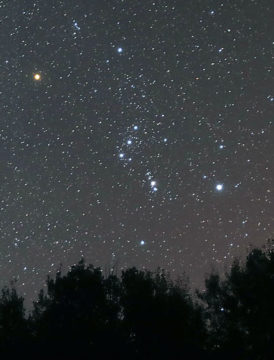
Bob King
Recently, I set my alarm for 4 a.m. for an hour of observing before the start of dawn. Fall brings later sunrises that make it possible to go to bed at 10 p.m. and still garner enough sleep to make it through the following 8-hour workday. Winter's even better, but yes, much colder.
The wee hours have always been special ones for me since the time I began exploring the night sky. From an early age I learned to tiptoe through the halls of my home when everyone else was asleep so as to make as little noise as possible. I zipped up my jacket deliberately and closed every door on the way out by hand to avoid slam-backs. Once under the sky, I was an animal escaped from its cage. I loved the morning stars and my dark-hour freedom spiced with a dash of danger should I accidentally wake up a family member coming or going.
As skywatchers know well, the Earth rotates through the night. In the evenings we see the familiar seasonal sights, but wait until morning and a new season's stars fill up the eastern sky. Getting up before dawn let me see into the future, one of my only magical super powers. In September, when the Summer Triangle would begin the night, I'd wake to Orion and that glorious belt.
When the world is in bed and traffic calms, mornings bring a hush that we rarely experience during evening observing. It's the quietude that adds a sacred quality to morning observing. Just you and the crickets. Silence is in such short supply these days, the experience of it makes you stop and catch your breath. Not only are quiet and solitude calming, they uncork the senses, allowing a keener awareness of the natural world and a deeper connection to our surroundings. This is a good feeling.
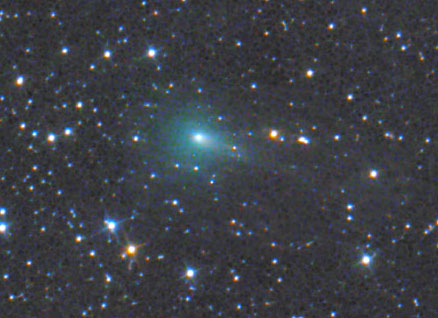
Mikhail Maslov
Once dawn blues up the eastern sky, I pack away the telescope and quietly slide back into bed, happy to have found my way back to the universe again.
I got the scope out before dawn a couple weeks ago and looked for and found the newly-returning comet 38P/Stephan-Oterma in Orion and its brighter relation, 21P/Giacobini-Zinner, in Gemini. Both comets still ply the sky during the small hours; I've included maps to help you find them when the Moon bows out next week.
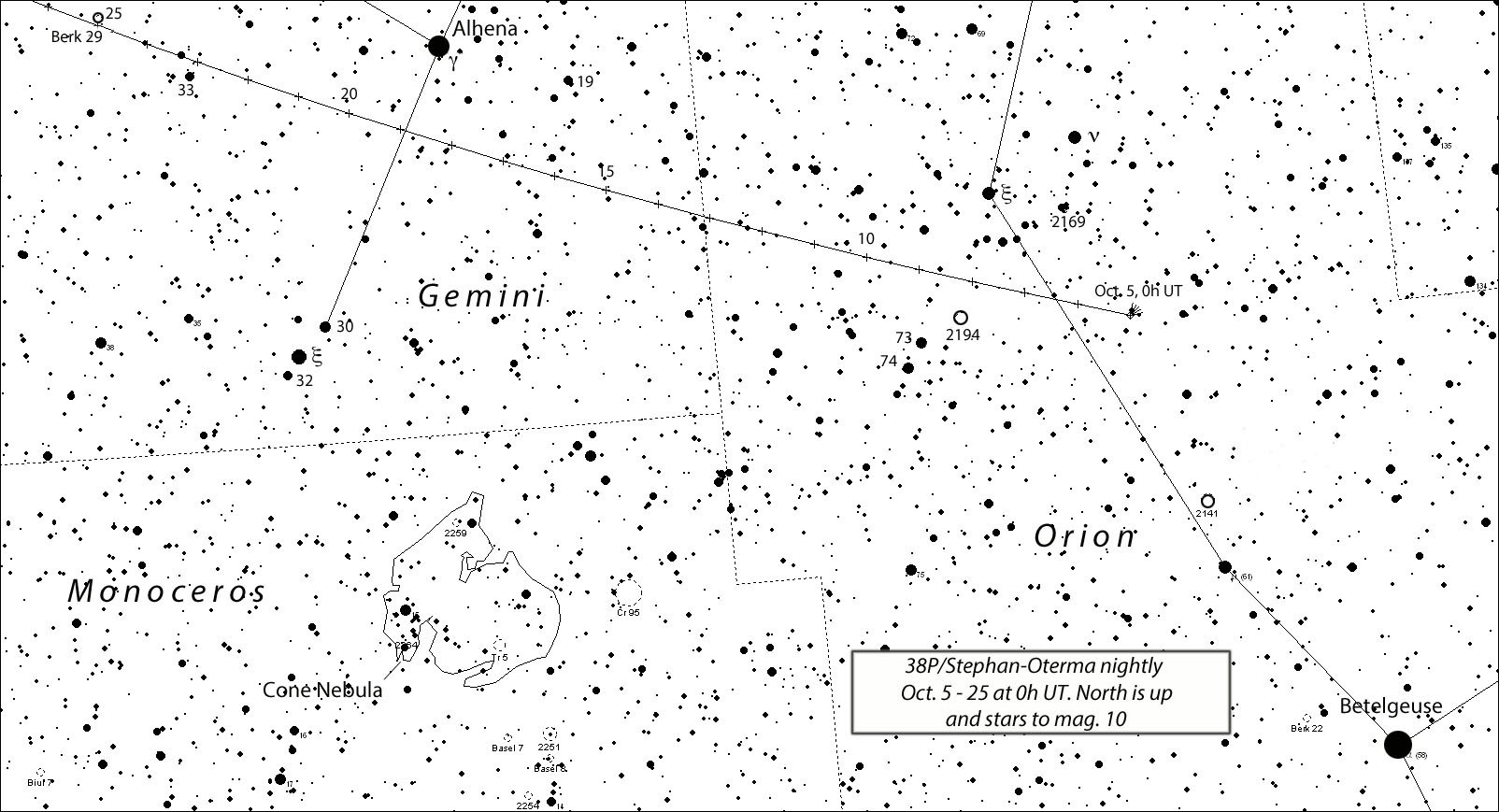
SkyMap with additions by the author
Both are also visible in modest telescopes, with 21P still bright around magnitude 7.6 and flashing a 1° westward-pointing tail. 38P shines about three magnitudes fainter and appears much less condensed with a 5-arc-minute coma. With an orbital period of 37.7 years, most of us only get two chances in a lifetime to spot it. Carpe cometa!
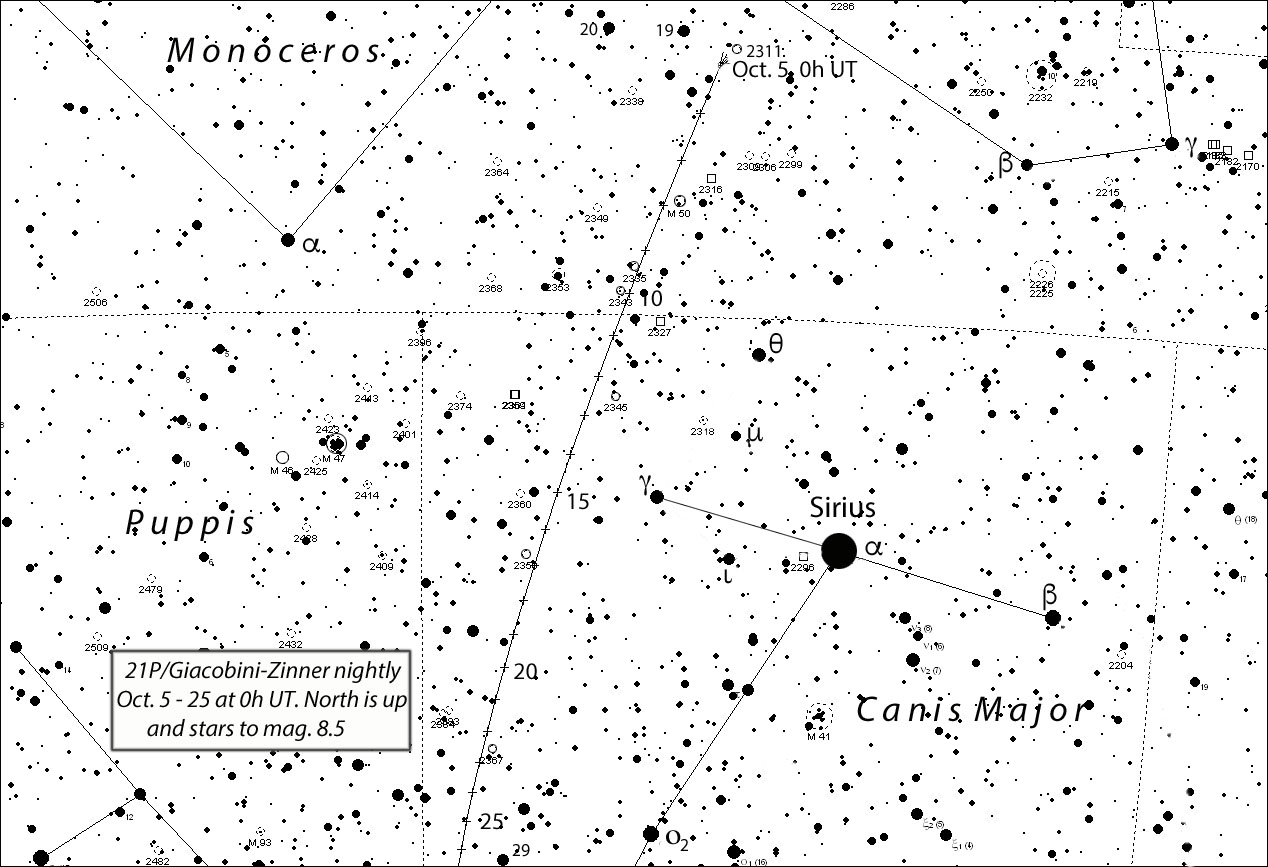
SkyMap with additions by the author
Mid-September marks the beginning of the dawn zodiacal light season. After finishing up at the telescope I made a short field trip to a big field with a wide open vista of the eastern sky. Whoa! At 5:15 a.m. the tapered glow of the zodiacal light reached from the Sickle of Leo at the eastern horizon all the way to Milky Way in Taurus, a span of 60°. It was an incredible sight, towering over the distant trees like some giant, headless comet.
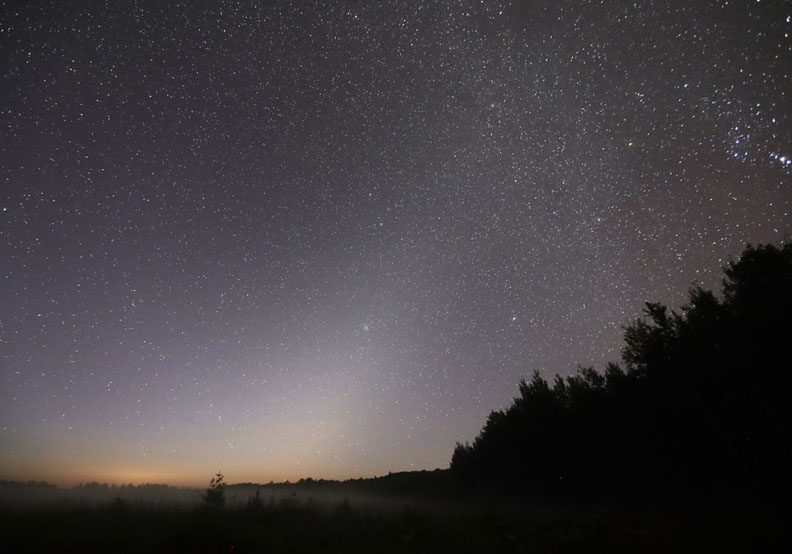
Bob King
And that's exactly what it is — primarily comet dust, with some added debris from asteroid collisions, lingering in the plane of the solar system.The material scatters sunlight well, and since it lies in Earth's orbital plane, we see it along the ecliptic, the same path taken by the planets, Sun, and Moon.
In fall, the ecliptic tilts up steeply from the eastern horizon before dawn, lifting this fat finger of dust up and away from the horizon murk and into a dark sky. The cone of light is brightest and widest at its base because that part is physically closest to the intensely bright Sun. The farther up you gaze, the narrower and fainter the finger. To see the light in its glory, find a spot with a great view to the east and start looking about a half-hour before the beginning of morning twilight. You'll see it best when the Moon's out of view from October 7–23 and November 5–21.
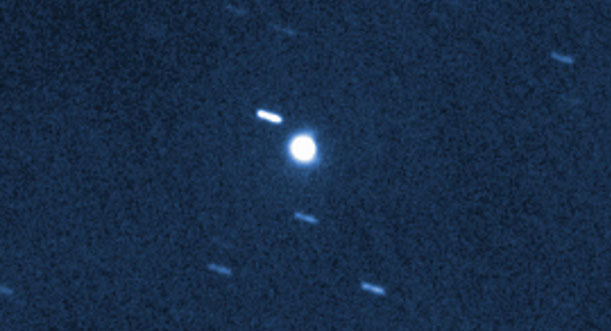
Jean-François Soulier
Now for some great news for evening skywatchers. On about September 20.5 UT, Comet 29P/Schwassmann-Wachmann underwent a bright outburst, morphing from a vague, diffuse 13th-magnitude patch to a bright little ball of light. At the moment, it's about magnitude 12 and ~20″ (arcseconds) across, like a small planetary nebula. It's possible it will get brighter still, so I strongly encourage you to take a look. The Moon should be out of the way by the 26th — just in the nick of time.
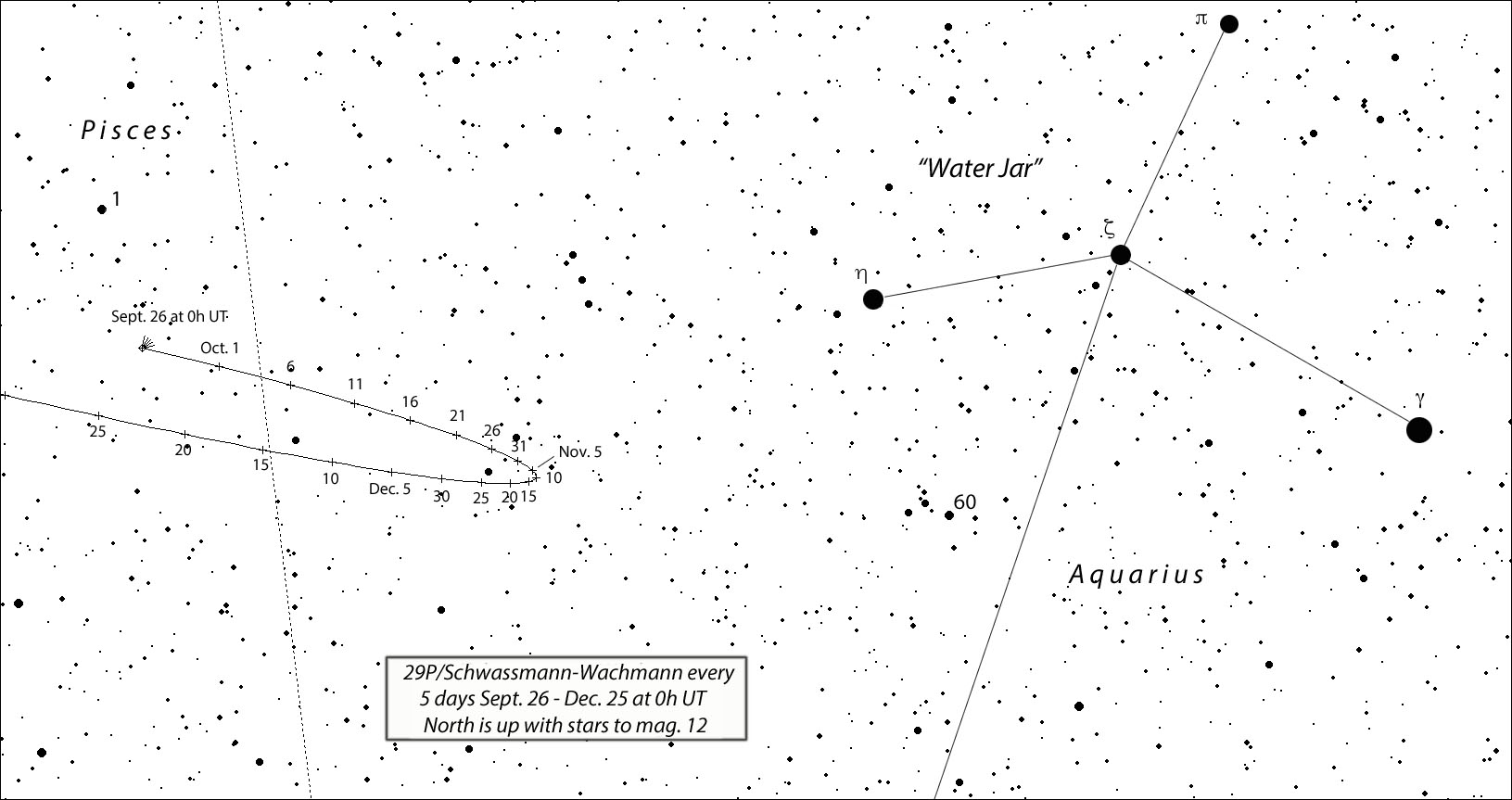
SkyMap with additions by the author
The comet's been very active this year and more outbursts are expected. To learn more about 29P's explosive nature and possible causes, check out my earlier blog. Clear skies!
 6
6








Comments
Anthony Barreiro
September 26, 2018 at 7:50 pm
Carpe stella crinita per cauda.
Even here in a light-polluted city, the hour before dawn is the best time for back yard skywatching. All my neighbors are still in bed, so no extra lights from their windows. Fewer cars on the roads, fewer businesses open. There's less air pollution so if the weather is clear the air is clearer, and everything has cooled down overnight so the seeing is steadier than in the evening, when all the streets and buildings are radiating heat.
One early morning in 2016 I got a perfectly steady view of Mars at 100x through a 70 mm refractor. The northern polar cap, Syrtis Major, and Hellas Basin were all perfectly clear. I was exceedingly happy all day at work.
You must be logged in to post a comment.
Bob KingPost Author
September 27, 2018 at 12:11 pm
Anthony,
That was my original motivation as a kid growing up north of Chicago. I'd go out in the early morning when I heard there would be less lighting. That was in the mid-60s already.
You must be logged in to post a comment.
TomR
October 2, 2018 at 11:17 am
Dear Bob,
thanks for all of your great articles, you are my favorite author in sky&telescope. I think that everyone can feel your love for astronomy.
The hour before dawn is really a sacred hour. This is the time, when the monks get up for their morning prayer and astronomers adore the sky. For me astronomy has also philosophical or theological aspects. Sometimes I think that astronomers have the unconscious wish to be one with the cosmos.
Thomas, Austria
You must be logged in to post a comment.
Bob KingPost Author
October 2, 2018 at 11:39 am
Thank you so much Tom for your kind words. And I agree — we not only seek to understand the cosmos but relish those times when we lose our sense of personal identity and become one with it. Astronomy has always been (for me) as much a philosophical and spiritual pursuit as a scientific one.
You must be logged in to post a comment.
Martian-Bachelor
November 18, 2018 at 10:06 pm
I don't know if anyone else on the planet has been observing 38P/Stephan-Oterma, but I've gotten it several nights in the last two weeks or so (i.e., since the moon got out of the way).
Two nights ago it was almost due S of Pollux a little less than 5 degrees. It's rather faint compared to 21P/Giacobini-Zinner two months ago -- little more than a small fuzzy blob that moves a little over 10's of minutes.
You must be logged in to post a comment.
Bob KingPost Author
November 20, 2018 at 3:22 pm
Hi MB,
I saw it about two weeks ago and found it fainter than expected and rather diffuse. Not too difficult in my 15-inch under mag. 5.5 skies.
You must be logged in to post a comment.
You must be logged in to post a comment.